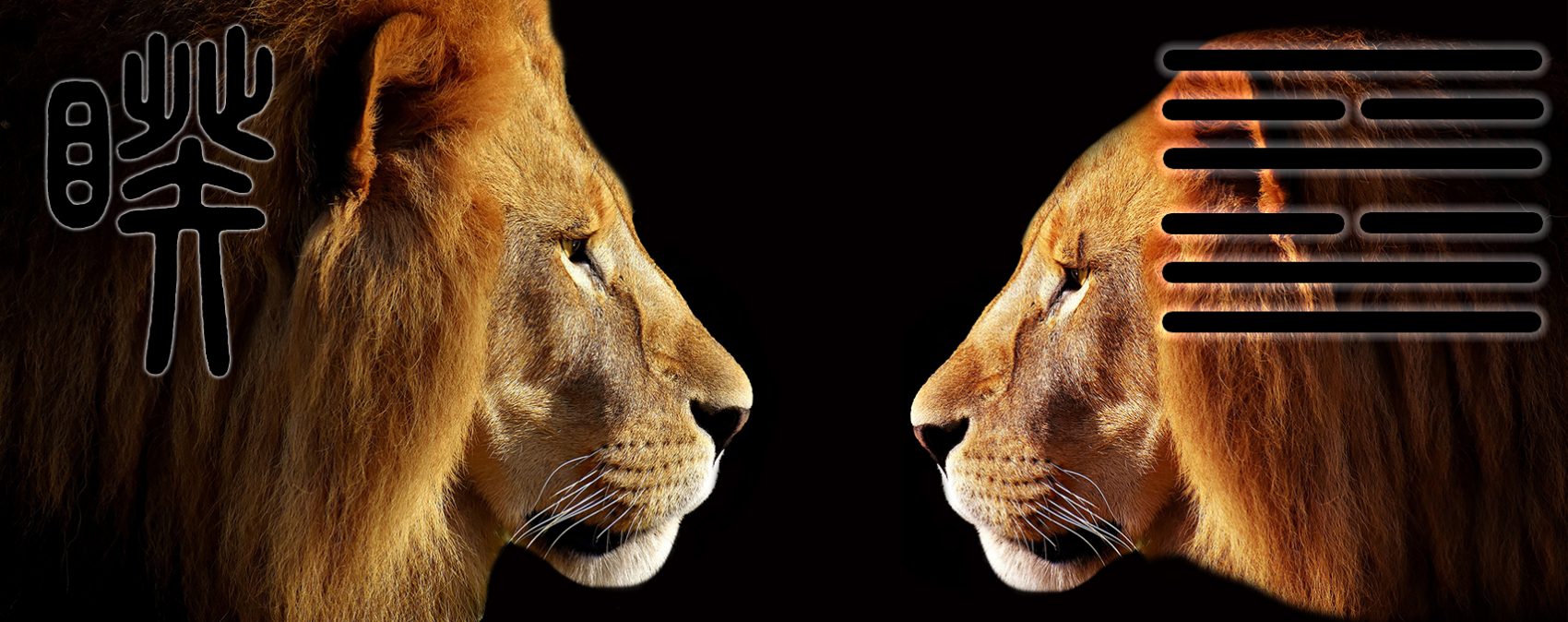Fire above – Lake below
The Chinese name of this hexagram is Kui which translates to estranged, divergent, incompatible, going against. Some titles of this hexagram include: Opposition, Separation, Estrangement, Mutual Alienation. The original idea is the “eyes do not look at each other” which, according to ancient philosophies means: “although the eyes may meet, there is no shared vision”. Some ancients characterized Fire as the middle daughter and Lake as the youngest daughter within a family. Although they grow up in the same household, their paths will naturally diverge, especially when they marry and take on the interests of their husbands, their children and in-laws. Thus, diversity was understood as not only inevitable, but desirable even though it holds challenges. Breaking down the symbolism of the 3-line trigrams helps with understanding the ancient teachings.

When trigram Lake is below (the bottom 3 lines in image below right), it references the inner realm of the person or situation. Lake represents a joyful opening up to and exchange with others. Lake is also called “Marsh” because it a place to meet with others. Because Lake is also associated with the element of water, there is the added unpredictability of the emotional realm.
Trigram Fire is on top of trigram Lake (top 3 lines in image below right) indicating the outer or external environment of this hexagram. Fire in the outer realm provides light to distinguish one thing or one person from the other, showing where there are similarities or differences. The gift of fire is intelligence and discernment, the ability to decide who and what is of value to you and what to avoid.
The ancient ideograph is on the upper left portion of the image below. On the left portion of the image an eye is set vertically. On the right portion two hands, whose palms do not face each other, showing incompatibility or separation. This separation is furthered by the lowest image depicting a bow and arrow flying between the hands to further separate them, illustrating diversity.

In summary: Fire burns upward and Lake (water) flows downward, separating into divergent directions. Diversity is a necessity at every level of existence for the “whole” to survive. In general, Kui represents a challenge and an opportunity for growth. These are situations where different points of view can either block further progress or open entry into some level of transformation through finding common ground. The goal of this hexagram, though not necessarily always easy, is aimed at learning to work successfully with those who are different without anyone giving up their individuality; holding both diversity and uniqueness at the same time. Perhaps owing to the inherent challenge, the measure of success in Kui is meant or expected to occur in small rather than grand ways.
Following are a few ideas for interpretations of each line:
Line 1 – When encountering differences, it is best not to react or assume they are meant to cause personal harm as this attitude only weakens you. The chances are, in this situation, the problem will resolve itself. Your best course of action at this time is to take honest inventory of your own prejudices or limiting attitudes as reflected back to you by your internal response. This self-inventory is a good practice to get into before you speak out against anyone.
Line 2 – Unexpected meetings or encounters happen in sometimes surprising and perhaps uncomfortable ways. Teachers, masters or helpers come to us in many guises. If the discomfort in an encounter is acute, it may be this is a fated opportunity for self-examination and personal growth.
Line 3 – Although this may be a difficult time when things in life do not seem to be moving, it is best if you are able to meet issues of diverging views or opinions without making it more difficult or a bigger issue than it needs to be. The challenge here is to see if your own misconceptions are holding you back from honoring the divergent perspectives and needs of others or if this is an occasion to quietly honor your own individuality.
Line 4 – When standing firm in personal values, there are likely to be periods where friends are scarce. It is easy to feel alone and isolated. It is at these times you may find an unexpected ally who, although they may differ in their vision, can join you in opening doors that would have otherwise been closed. This type of connection would not be possible if you still had the comfort zone of friends surrounding you.
Line 5 – When meeting with others do not automatically assume you know who they are by their surface differences. In this time of diversity, making assumptions means you may miss out on someone of real value in your life. The best thing you can do is look below the surface because similarities cannot be seen when defenses are in the way. Take time and watch others’ actions to ascertain their level of integrity. Sometimes someone who looks like a potential enemy may turn out to be a friend and ally.
Line 6 – You may not be seeing people as they are because you are full of doubts or feel isolated. Perhaps past misunderstandings cloud your vision – let them go. It is important to recognize and allow for others’ uniqueness and recognize differing views are a natural and acceptable part of life, some even resulting in good fortune.
